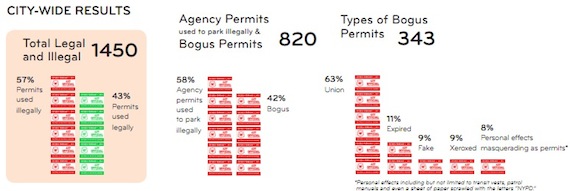
What happens when you put a police station, a courthouse, and borough hall in one place? Utter lawlessness.
In a new report [PDF], Transportation Alternatives looked at the dashboards of the vehicles parked in the civic centers of each borough. In areas just a few blocks wide, hundreds of vehicles were displaying placards boasting of their special parking privileges. Fifty-seven percent of them were being used illegally.
In Concourse Village in the Bronx, for example, half of the 262 placards on display in a mere five block area were legitimate permits improperly being used to park, perhaps in a no standing zone or on the sidewalk. The other half were simply fake: they were handed out by the police union, a photocopy of another placard, or an item like an NYPD patrol manual that implies that the owner is a cop.
In Manhattan's civic center, the problem was even worse. Only eleven out of 244 placards on display in a thirteen block area were being used legally.
At a press conference in front of City Hall today, T.A. joined with Council Members Dan Garodnick, Leroy Comrie, and Margaret Chin to call for an end to placard abuse. One top priority is Garodnick's bill to put bar codes on official placards in order to make it easy for traffic enforcement agents to know with just a scan whether a placard is real and being used legitimately.
"It's dangerous," said T.A. executive director Paul Steely White. "When motorists are parking in front of fire hydrants, in front of crosswalks, on sidewalks, they're blocking emergency vehicles from getting through. They're making life very difficult and dangerous for pedestrians in particular." Placard abuse also contributes to congestion by giving a sizable population free parking wherever they like.
Garodnick argued that putting bar codes on placards would not only give traffic agents the information they need to enforce the law, it would also empower them to take on the privileged placard-holders by creating a bright line rule. "Parking permits denote a level of prestige and privilege and many traffic agents do not want to risk running up against someone in a position of power," said Garodnick. "If there's no bar code, there's no reason not to write a ticket for a parking offense."
Garodnick's bill currently has 21 sponsors. Though a hearing has not yet been scheduled for the bill, said Garodnick, Transportation Committee chair Jimmy Vacca has expressed interest in holding one.
"This is a commonsense bill," said Comrie. "Our retail centers are losing available parking because of people that are parked all day while they're walking less than half a block to get to their jobs." In Jamaica, which Comrie represents, the T.A. study found that 59 percent of placards were being used illegally.
Small business owners from St. George and Atlantic Avenue joined Comrie in attacking placard abuse for making it hard to get deliveries and for customers to reach their stores safely on foot or easily in a car. "Our neighborhood has become a park-and-ride," said St. George gallery owner Theo Dorian.
"For many years, activists in Chinatown have been fighting against all this placard parking," said Chin. "Let's get this bill passed."
While the bar code bill would help cut down on placard abuse, change can't happen until the police department decides to change its priorities. Adding barcodes won't make it any more obvious that placard holders can't park in front of a fire hydrant, for example, nor will it stop the police from passing over cars displaying a "clergy" sign that doesn't purport to be an official placard in the first place.
Garodnick also called for further reductions in the number of official placards handed out in the first place. Though the Bloomberg administration reduced the number of placards it issued by roughly 40 percent, there are still seventy-eight thousand legal placards out there. "Seventy-eight thousand seems like an awfully high number," said Garodnick. T.A.'s study was an update of its previous two investigations of placard abuse, Uncivil Servants and Above the Law.





